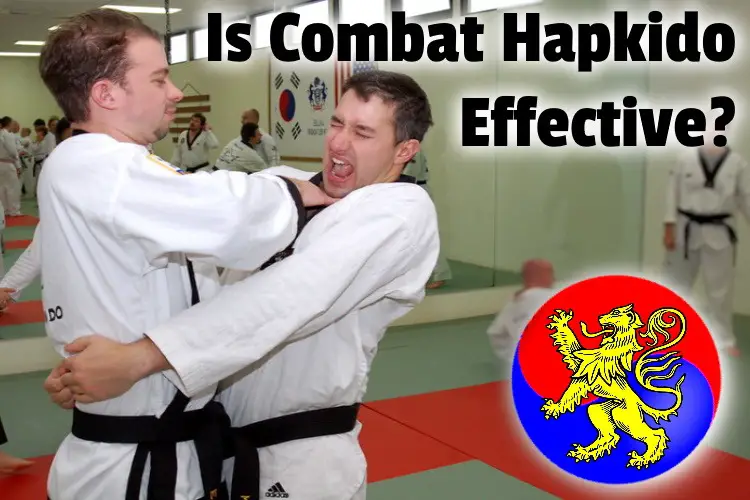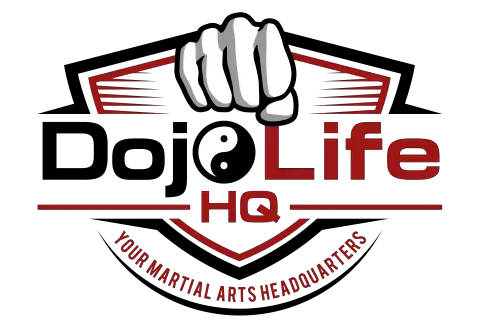Hapkido is a Korean martial art that combines both standing and groundwork and elements from many other martial arts. Combat Hapkido is a more modern approach of using the best elements of Hapkido purely for self-defense. But is Combat Hapkido effective?
Combat Hapkido is highly effective. It was developed to address self-defense, and it’s a hybrid system with elements from other top martial arts such as Judo, Jiu-Jitsu, and Tang Soo Do. It has techniques for dealing with modern weapon attacks, too.
But is it easy to learn? Are there a lot of dojos that teach it? And how does it compare to other martial arts for self-defense? That’s what we’re getting into in this article.
Let the fun begin…

Is Hapkido different from Combat Hapkido?
Hapkido is the original, traditional Korean martial art developed following World War II by Choi Yong-Sool. Combat Hapkido, by comparison, was developed from Hapkido in 1990 in the United States by John Pellegrini.
Both share many elements, but there are differences. As its name suggests, Combat Hapkido is focused on self-defense.
Some elements of traditional Hapkido, such as meditation, acrobatic break falls, jumping, spinning, and forms, have been ignored in developing Combat Hapkido.
It was felt that they’re impractical.
Hapkido (way of coordinated energy) is a Korean martial art. In principle, it’s similar to Aikido, although technically it’s roots are in Jiu-Jitsu.
It employs circular foot sweeps, circular throws, punches, and kicks.
Because of its focus on circular motion, it’s easy to transition from one technique to another. One can easily change the direction of the force by changing the axis of rotation.
Joint locks, throws, and dynamic kicking techniques are some of its core elements. It was designed to teach how to counter an attack, not so much by attacking but by seeking to deflect the attacker’s energy.
It’s regarded as one of the original mixed martial arts because of its roots in Jiu-Jitsu, and the fact that it incorporated striking and punching from Tang Soo Do, a Korean form of Karate.
It’s an art that was developed to equip practitioners with the skill to be able to contend with someone skilled in multiple martial arts.
Some #combat #hapkido at @ASDSantaClara pic.twitter.com/xHkN6UtdNF
— Ev Pepper (@modern_hapkido) July 18, 2018
Is Combat Hapkido good for self-defense?
Combat Hapkido works well for self-defense and that was the primary purpose for its development. It removed the more esoteric elements of traditional Hapkido, and simply focused on the simplest and deadliest elements to form a highly effective self-defense system.
As I mentioned above, John Pelligrini developed it in 1990 when he felt that the traditional form of Hapkido leaves a lot to be desired when it comes to self-defense.
Let’s even hear from the horses’ mouth.
“Forget the fancy high kicks, lose the forms, and stop wasting time with healing, meditation, and breathing exercises or outdated traditional weapons training. It’s time for people to get down to business so they can learn to protect themselves. They must forgo the stuff that is not connected to self-defense.”
Mr. Pelligrini is of the opinion that the self-defense part of the training of a martial artist is what should come first. He said that folks could learn the health and fitness stuff at a gym or on their own.
Combat Hapkido is a comprehensive, up-to-date self-defense system. It has elements such as defenses against empty-hand assaults, knife attacks, gun threats, and impact weapons.
To further the goal of a complete self-defense system, Combat Hapkido has borrowed from Kuntao Silat, Jiu-Jitsu, Jeet Kune Do, and Boxing.
What of Aikido? Is it effective as a self-defense system?
That’s what I dwelt on in a recent article of mine. I compared it to Hapkido above. But a lot of people see Aikido as weak or fake due to its focus on harmony and not doing harm to others. However, there’s one aspect that can be totally brutal.
Just click the link to read it on my site.
Combat Hapkido Seminar w/ Grandmaster Pellegrini @tmmartialarts #martialarts #combat #hapkido pic.twitter.com/o9O213oqC2
— TM Martial Arts (@tmmartialarts) May 2, 2015
Which is better: Hapkido or Karate?
Hapkido is better than Karate since it combines the best elements from Tang Soo Do (Korean Karate) in conjunction with other martial arts elements from Jiu-Jitsu, Judo, and Korea’s oldest martial art, Taekkyon.
But ultimately, it depends on what you’re looking for.
There are those who are interested in fun, competitive, and safe martial arts. There’s nothing wrong with this. And there are those who are seeking something hard-core. Something lethal. Something that could be a lifesaver in case they’re caught in dangerous situations.
So, objectively speaking, there’s no question of “better”.
It depends on what you want or what a particular situation calls for. If you’re contending with a pickpocket who’s simply out to snatch your wallet, knowing Karate might be all that you need to chase them off.
But, if someone is trying to do all they can to hurt you or assault you in any form, you’d be better off with Hapkido.
Karate is more of a sport, while Hapkido, even though not popular, is more of a self-defense system. And because it’s a hybrid, you have more techniques to draw upon and use depending on the context.
Of course, it’s always better to be versed in multiple arts.
Have you ever wondered which one would be better, Aikido or Hapkido?
I looked at both systems in a recent article of mine and suggested which one you should choose. I’ve practiced Aikido, but not Hapkido, although I do have some experience with Tang Soo Do. But I have a clear favorite between these two.
Just click the link to read it on my site.
Loved sponsoring a self defense course for college aged women led by NJ Combat Hapkido! #fightlikeagirl #Empowerment #empoweringwomen #SelfDefense #collegelife #BeAware #livealifeofpurposeandpassion pic.twitter.com/xlRHMNvmB7
— Dr. Liz (@drlizconsulting) December 31, 2017
Why is Hapkido not popular?
Hapkido is not as popular or well-known as other martial arts because it is not designed for entertainment. Without flashy moves, a martial art will be seen less on TV and in movies. It is also not typically seen in MMA fighters.
The most popular martial arts would be Karate and Judo due to their inclusion in the Olympics. And Brazilian Jiu-Jitsu gained popularity thanks to the Gracie family and how much they dominated the UFC initially.
And admittedly, those martial arts are a lot of fun to watch. They also attract a lot of money for the promoters. But, the reality is that, in a way, they can lose their essence.
For that reason, you do see some schools such as Valente Brothers in Miami, that no longer use the Jiu-Jitsu name. But they still have Hélio Gracie’s Gi mounted on the wall since the Valente family was trained in Jiu-Jitsu by Helio.
So Hapkido is not about graceful dances and seemingly choreographed movements. The focus is on self-defense. In fact, the focus entails being able to subdue highly skilled martial artists.
Hapkido is also highly involved.
There’s so much to learn. And there’s also a system of continuous learning that’s required, even after attaining mastery. There are so many “modules” for constant development. In truth, some of the most deadly arts are not really popular.
I suspect these are the major reasons Hapkido is not popular.
Where I live (outside of Austin, TX) we had a Hapkido school when I first moved here. But it closed and is now a Jiu-Jitsu school.
Teach, learn and love what you do. COMBAT HAPKIDO pic.twitter.com/Va3v05bcPX
— Joe Lyons (@billyjoelyons1) July 13, 2016
What are the top Combat Hapkido techniques?
The top techniques in Hapkido include strikes, kicks, takedowns, grappling, joint locks, pressure points, and disarming opponents.
Let’s check out one or two to have a taste of the system.
This technique was described by the founder, Joe Pelligrini. It’s under the Empty Hands category (elbow entry, takedown, and reverse armbar).
First, stand in a Combat Hapkido awareness position.
It’s the kind of stance that boxers adopt. Your open hands are held just below eye level. An attacker approaches you and is about to strike you with his right hand.
What do you do?
Step forward to the outside of your lead foot, that’s your left. Lift your right elbow directly in front of your centerline. It’s keeping him from making contact, and it enables you to close the gap.
Drop your elbow, trap his deflected right arm with your right arm.
Hit the side of his face with a left palm heel. Maintain contact and drive him backward until he falls. Make your grip more secure and drive your knee to the right side of his neck and then jam your left thumb into a pressure point located on the side of his neck!
That gives us a taste of how deadly the system can be, right? Of course, what I described would be done at a fast pace, which makes it more lethal.
Say you have to choose between Aikido and BJJ. Which one is better for self-defense?
You’re in luck because that’s what I explored in a recent article of mine. I offered advice about which one is better, although I have a lot more experience doing BJJ. However, there’s one Aikido move I absolutely love!
Just click the link to read it on my site.
Conclusion
In this article, we explored some vital info about Combat Hapkido and its effectiveness.
But more importantly, we looked at how it differs from traditional Hapkido, and whether it’s really a good self-defense system. However, we also looked at why it’s not as popular or well-known as other martial arts.
After all, the less popular an art is, the harder it will be for you to find a dojo that offers it.
Photo which requires attribution:
spear-hand in the throat. ouch. by Scott Feldstein is licensed under CC2.0
